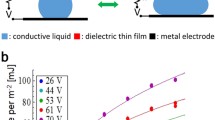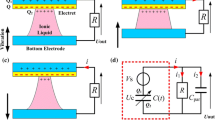Abstract
This paper presents an energy scavenging technique, merging microfluidics with electrostatic energy harvesting. The method employs droplet-based microflow of two phases with different electrical permittivities, resulting in a capacitance change across the microchannel, to harvest electrical energy. The technique is implemented on 3 mm wide, 1 mm deep minichannels. It is shown that 0.4 nW can be harvested using a single electrode pair, with air and water as the two phases flowing at 1 ml/min. The generated power can be increased significantly by microscale implementation, where the number of electrodes can also be increased for further improvement.




Similar content being viewed by others
References
Bashir R (2004) BioMEMS: state-of-the-art in detection, opportunities and prospects. Adv Drug Deliv Rev 56:1565–1586
Beeby SP, Torah RN, Tudor MJ, Jones PG, O’Donnell T, Saha CR, Roy S (2007) A micro electromagnetic generator for vibration energy harvesting. J Micromech Microeng 17:1257
Borno RT, Steinmeyer JD, Maharbiz MM (2009) Charge-pumping in a synthetic leaf for harvesting energy from evaporation-driven flows. Appl Phys Lett 95:013705
Carmo JP, Goncalves LM, Correia JH (2010) Thermoelectric microconverter for energy harvesting systems. IEEE Trans Ind Electron 57:861–867
Guilar NJ, Kleeburg TJ, Chen A, Yankelevich DR, Amirtharajah R (2009) Integrated solar energy harvesting and storage. IEEE Trans Very Large Scale Integr Syst 17:627–637
Hughes RC, Ricco AJ, Butler MA, Martin SJ (1991) Chemical microsensors. Science 254:74–80
Mateu L, Codrea C, Lucas N, Pollak M, Spies P (2007) Human body energy harvesting thermogenerator for sensing applications. In: International conference on sensor technologies and applications, pp 366–372
Meninger S, Miranda JOM, Amirtharajah R, Chandrakasan A, Lang JH (2001) Vibration-to-electric energy conversion. IEEE Trans Very Large Scale Integr 9:64–76
Miao P, Mitcheson PD, Holmes AS, Yeatman EM, Green TC, Stark BH (2006) MEMS inertial power generators for biomedical applications. Microsyst Technol 12:1079–1083
Paracha AM, Basset P, Marty F, Chasin AV, Poulichet P, Bourouina T (2007) A high power density electrostatic vibration-to-electric energy converter based on an in-plane overlap plate (IPOP) mechanism. In: Proceedings of symposium on design, test, integration and packaging of MEMS/MOEMS, Stresa
Poulin G, Sarraute E, Costa F (2004) Generation of electrical energy for portable devices: comparative study of an electromagnetic and a piezoelectric system. Sens Actuators A Phys 116:461–471
Qin Y, Wang X, Wang ZL (2008) Microfibre-nanowire hybrid structure for energy scavenging. Nature 451:809–813
Qu W, Plötner M, Fischer WJ (2001) Microfabrication of thermoelectric generators on flexible foil substrates as a power source for autonomous microsystems. J Micromech Microeng 11:146–152
Raghunathan V, Kansal A, Hsu J, Friedman J, Srivastava M (2005) Design considerations for solar energy harvesting wireless embedded systems. In: IPSN’05: Proceedings of the 4th international symposium on information processing in sensor networks, pp 457–462
Roundy S, Leland ES, Baker J, Carleton E, Reilly E, Lai E, Otis B, Rabaey JM, Wright PK, Sundararajan V (2005) Improving power output for vibration-based energy scavengers. Pervasive Comput 4:28–36
Sari İ, Balkan T, Külah H (2010) An electromagnetic micro power generator for low frequency environmental vibrations based on the frequency upconversion technique. J MEMS 19:14–27
Sterken T, Fiorini P, Baert K, Puers R, Borghs G (2003) An electret-based electrostatic-generator. In: 12th International conference on solid-state sensors, actuators and microsystems. Boston, pp 1291–1294
Wang J (2006) Analytical electrochemistry, 3rd edn. Wiley, New Jersey
Wang ZL, Song J (2006) Piezoelectric nanogenerators based on zinc oxide nanowire arrays. Science 312:242–245
Woodson HK, Melcher JR (1968) Electromechanical dynamics, vol 1. Wiley, New York
Yazdi N, Ayazi F, Najafi K (1998) Micromachined inertial sensors. Proc IEEE 86:1640–1659
Acknowledgments
The authors would like to thank Prof. Engin Atalar, Prof. Abdullah Atalar, and Ms. Elif Aydoğdu for the discussions on the operation principle of the proposed harvester.
Author information
Authors and Affiliations
Corresponding author
Rights and permissions
About this article
Cite this article
Yıldırım, E., Külah, H. Electrostatic energy harvesting by droplet-based multi-phase microfluidics. Microfluid Nanofluid 13, 107–111 (2012). https://doi.org/10.1007/s10404-012-0946-2
Received:
Accepted:
Published:
Issue Date:
DOI: https://doi.org/10.1007/s10404-012-0946-2




